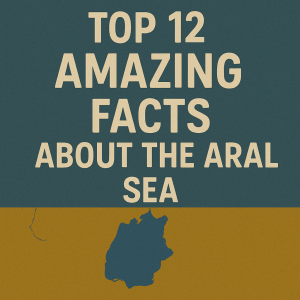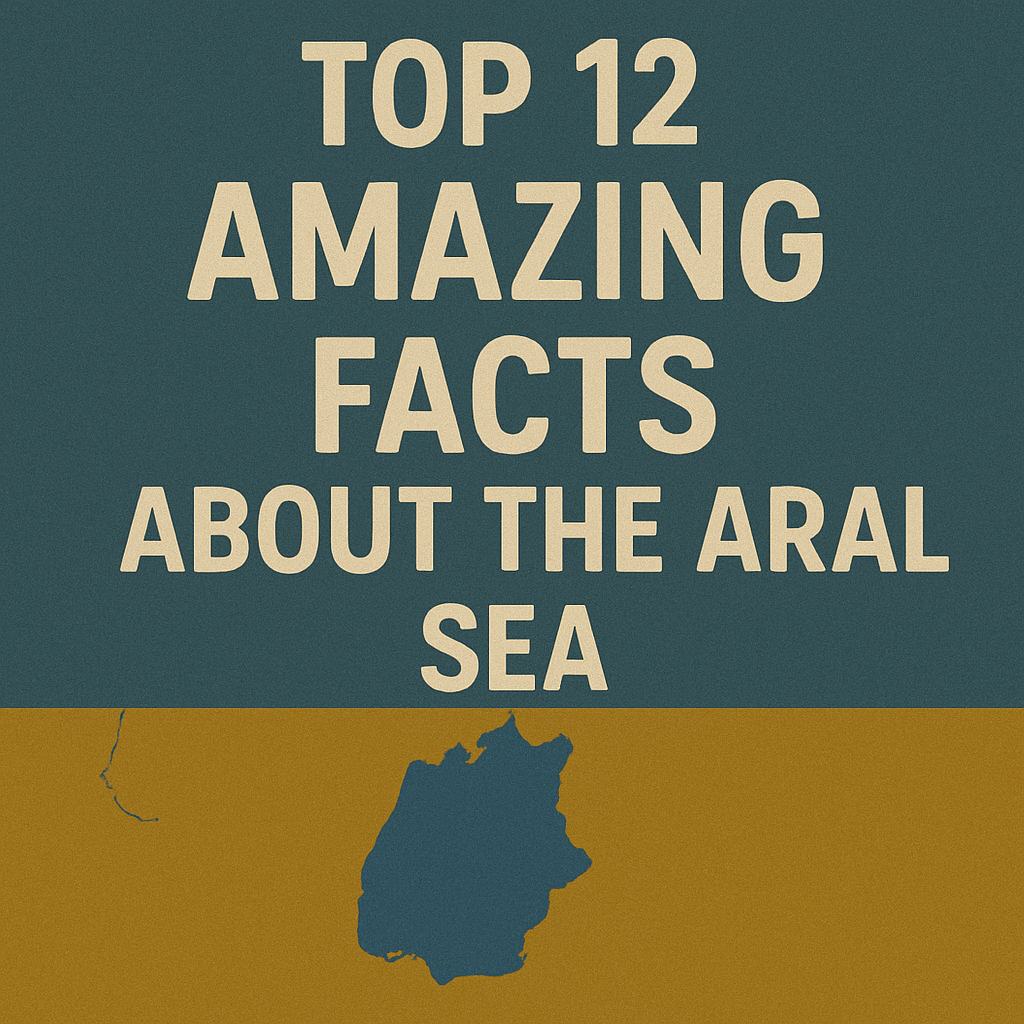Discover 12 astonishing facts about the Aral Sea, once the fourth-largest inland water body on Earth. Learn how maritime mismanagement and environmental missteps turned a thriving sea into a shrinking symbol of ecological crisis, and what lessons it holds for the global maritime industry.

Why the Aral Sea Still Matters in Maritime and Environmental Discussions
Once stretching across the heart of Central Asia between Kazakhstan and Uzbekistan, the Aral Sea was a symbol of prosperity, biodiversity, and regional unity. But over the last half-century, it has morphed into one of the world’s most striking examples of ecological collapse. For maritime professionals, students, and policy-makers, the Aral Sea offers urgent lessons about water management, sustainability, and transboundary cooperation.
The decline of the Aral Sea is more than an environmental tragedy; it is a maritime case study. It affects port operations, shipping routes, fishing communities, naval strategy, and even regional security. As coastal zones and marine ecosystems face increasing stress from climate change and over-exploitation, the Aral Sea becomes a powerful warning—and an opportunity to learn.
Let’s dive into 12 fascinating facts about this disappearing sea and what they mean for the maritime world.
A Sea That Became a Desert
In the early 1960s, the Aral Sea was the fourth-largest inland sea in the world, spanning over 68,000 square kilometers. By the 2000s, it had lost more than 90% of its volume.
What happened? During the Soviet era, massive irrigation projects diverted water from the Aral’s two main feeding rivers—the Amu Darya and Syr Darya—to grow cotton in the desert. These unsustainable withdrawals caused the sea to shrink rapidly.
Analogy: Like a bathtub with the tap turned off and the plug pulled out, the Aral Sea could not survive without its lifeline rivers.
It Created a Maritime Graveyard
In the abandoned port city of Moynaq, Uzbekistan, ships now lie rusting in the middle of the desert—dozens of kilometers from the current shoreline. The shrinking of the sea turned once-thriving port towns into ghost settlements.
This maritime graveyard stands as a stark reminder of how the redirection of waterways can decimate entire industries. Global port authorities and coastal planners now look to the Aral Sea as a cautionary tale.
The Sea’s Salinity Quadrupled
As the water evaporated and wasn’t replaced, the salinity levels of the Aral Sea increased dramatically—from 10 g/L to over 100 g/L in some areas. This salinization made the water uninhabitable for most native fish species, killing off a once-vibrant fishing industry.
Fisheries that employed tens of thousands disappeared within a few decades, leaving communities in economic despair. It is a clear warning for other semi-enclosed seas like the Caspian and the Baltic, where salinity imbalances could similarly disrupt marine ecosystems.
An Island Became a Biological Threat
Vozrozhdeniya Island, once located in the middle of the Aral Sea, was home to Soviet biological weapons testing. As the sea receded, the island merged with the mainland, creating a potential public health and biosecurity risk.
According to declassified documents and the Centers for Disease Control and Prevention (CDC), pathogens like anthrax and plague may still remain active in the soil.
The Sea Has Its Own Dust Storms—Laced with Pesticides
The exposed seabed, now called the Aralkum Desert, contains layers of pesticides, fertilizers, and salt. Winds lift this toxic dust and carry it across hundreds of kilometers.
UNESCO reports that these dust storms cause respiratory diseases, increase cancer rates, and reduce agricultural productivity. These challenges echo the IMO’s environmental concerns under the MARPOL Convention about airborne pollutants and emissions affecting coastal populations.
International Maritime Research Focuses on the Aral Sea
The Aral Sea has attracted significant research interest from maritime scholars, particularly in journals like the Marine Pollution Bulletin and Ocean Engineering. Remote sensing tools such as MODIS satellite imaging have been used to track the retreating shoreline and sediment movements.
The European Space Agency (ESA) and NASA have also documented the Aral Sea’s changes using satellite-based digital mapping. This is a strong example of how marine spatial data is being used for environmental diagnostics.
One Dam Made a Remarkable Difference
In 2005, the Kok-Aral Dam, built with funding from the World Bank and Kazakhstan’s government, helped partially revive the North Aral Sea. Water levels rose by over 3 meters, fish species like the sazan (carp) returned, and small-scale fisheries reopened.
Though only a partial success, the Kok-Aral Dam offers hope that controlled engineering, when done sustainably, can help recover lost marine environments.
The Region Lost a Maritime Identity
Before the decline, the Aral Sea supported over 60,000 fishermen and port workers. Boats, shipyards, and lighthouses were integral to the regional economy. The loss of the sea triggered a sociocultural disintegration, with traditional maritime knowledge lost across generations.
In modern-day Uzbekistan and Kazakhstan, local governments and international NGOs have started oral history projects to preserve what remains of the maritime heritage.
Climate Impacts Are Now Amplified
The Aral Sea used to moderate regional temperatures. Without its cooling effect, summers have become hotter and winters harsher, according to UNEP climate data. The maritime disappearance changed microclimates, leading to reduced rainfall and harsher winds.
Climate modelers use the Aral Sea as a reference for studying inland water-climate interactions, especially in Central Asia, the Sahel, and even regions near Lake Chad.
Maritime Education Uses It as a Case Study
Maritime academies and universities worldwide use the Aral Sea crisis to teach sustainable water and resource management. Institutions such as the World Maritime University (WMU) and Massachusetts Maritime Academy feature it in their syllabi to discuss policy failures, regional cooperation, and restoration potential.
It serves as a real-world warning about how inland maritime bodies can vanish if ecological balance is ignored.
International Legal Lessons Learned
The Aral Sea crisis is now frequently cited in international law and policy forums. Its case is discussed under transboundary water treaties such as the UNECE Water Convention.
Lack of legal obligation between states to preserve the ecosystem became a driver for today’s cooperative frameworks, especially those governed by UN Water, GWP, and ICWC (Interstate Commission for Water Coordination).
Restoration Is Possible—But Complex
Today, NGOs, governments, and international bodies are attempting to restore the Aral Sea, but the process is expensive and politically fraught. Major actors include the World Bank, UNESCO, and Kazakh and Uzbek environmental ministries.
There’s also a growing trend of involving local stakeholders, especially women-led water cooperatives and indigenous fishing communities, to create bottom-up restoration initiatives.
FAQ
Why did the Aral Sea shrink so dramatically?
Due to excessive irrigation projects that diverted water from its main inflows—the Amu Darya and Syr Darya—for cotton farming during the Soviet era.
Is the Aral Sea gone forever?
No, parts of the North Aral Sea have been partially restored thanks to the Kok-Aral Dam, though the southern portion remains largely desiccated.
What is the environmental impact of the Aral Sea’s drying?
It caused extreme salinization, dust storms, loss of biodiversity, and public health issues due to airborne toxins.
Are there still ships in the Aral Sea?
Only rusting shipwrecks in the former port towns like Moynaq remain as evidence of a once-thriving maritime life.
Can lessons from the Aral Sea be applied globally?
Yes, especially for managing inland waters, planning irrigation, and creating maritime policies that align with sustainability goals.
Conclusion
The story of the Aral Sea is both tragic and instructive. From a bustling maritime center to an ecological catastrophe, it offers lessons that no global maritime professional, student, or enthusiast can afford to ignore. In a world facing climate uncertainty and water scarcity, the Aral Sea stands as both a cautionary tale and a source of hope. Restoration is possible—but only through global cooperation, sustainable engineering, and education.
Whether you’re working in a ship design bureau, teaching maritime law, or navigating sustainability in port operations, the fate of the Aral Sea has something to teach us all.
References
- UNEP – Aral Sea Programme
- European Space Agency – Aral Sea Imagery
- World Bank – Aral Sea Rehabilitation Projects
- Marine Pollution Bulletin – Aral Sea Studies
- UNESCO Aral Sea Basin Projects
- World Maritime University – Curriculum Topics
- Massachusetts Maritime Academy
- NASA Earth Observatory – Aral Sea Changes
- International Commission for the Protection of the Danube River (relevant comparative case)
- MarineTraffic – Port Changes Around the Aral Sea
- IMO MARPOL Convention

